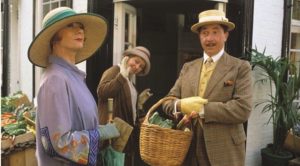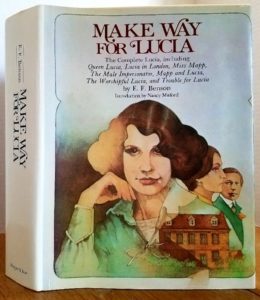At first glance, it’s a postcard-perfect seaside town, brimming with music, theater, and art. Look closer, though, and you’ll see that beneath the quaint village veneer lies a hotbed of intrigue, where colorful residents jockey for position on the town’s stepstool of a social ladder.
I’m speaking, of course, of Tilling, England, the fictional early-20th-century home of Emmeline “Lucia” Lucas, Elizabeth Mapp, and a dizzying array of townies whose shifting allegiances generate the comedy and the drama in E.F. Benson’s six-volume social satire collectively known as Mapp and Lucia. The novels have been a cult hit since their publication starting in 1920, spawning two television series and several radio adaptations in the U.K.

Though Benson’s Tilling and today’s Outer Cape are separated by more than 100 years and 3,000 miles, the parallels are obvious. Set aside Tilling’s persistent focus on aristocratic titles and English social norms, and you’ll find a small town where everyone knows everyone else’s business; where bitter rivalries arise over the pettiest slights; and where many residents are perfectly content to sit back and watch the most outspoken, audacious characters wage genteel war. Sound familiar?
Technically, Tilling could be a stand-in for many small towns around the globe. There are a few things, however, that make Mapp and Lucia a particularly apt analog for life on Cape Cod.
First, Tilling is a summer resort. Lucia’s arrival in town is made possible in part by an arrangement that Miss Mapp has made with her friends Diva Plaistow and Irene Coles — namely, that if Lucia rents Mapp’s house for the summer, Mapp will spend some of her earnings to rent Diva’s home, Diva will then rent Irene’s house, and so on. We might think that the Byzantine housing arrangements many Cape residents make every summer are a relatively recent phenomenon. Benson proves otherwise.
Like the Cape, Tilling is full of artists — actual, aspiring, and amateur. In the novels, determining whose art is superior drives much of the plot: who would be the best director for the summer fête? Who knows how to command attention onstage? Who’s the best pianist or painter? If you’ve ever meandered along Commercial Street during a summer gallery stroll or listened theater folks chat over tea (or at Tea), you may know what I’m talking about.
And last but certainly not least, like the Cape — and like Benson himself — Tilling is deeply queer. That’s exemplified most obviously by Lucia’s foppish, needlepoint-loving sidekick, Georgie Pillson, and the butch, refreshingly plain-spoken artist Irene (known as “Quaint Irene” around the village for her habit of smoking pipes while painting nude models). The coding of those characters is subtle by today’s standards. But a century ago, Georgie and Irene must have seemed about as subtle as a Pride parade.
As someone who was raised in small-town America (Laurel, Miss.), I found much of the Mapp and Lucia series wholly relatable, particularly the abundance of pearl-clutching, easily scandalized characters and the visibility of gender-nonconforming folks. I also love the crackle of Benson’s banter, which contains countless examples of withering low-key shade — the sort of verbiage a small-town gay boy in central Mississippi had to equip himself with as a defense mechanism.
The structure of the novels is reminiscent of P.G. Wodehouse’s Wooster and Jeeves books, where crises arise, resolve, and morph into new troubles. Any of them make for perfect bedside or beach reading, easy to put down and pick up again. The books have gone in and out of print in dozens of editions over the years, so finding copies isn’t especially difficult. True aficionados may want to track down a copy of the 1986 omnibus version, which includes all the Lucia books plus one of Benson’s related novels — a true doorstopper.
I realize what it’s like to have a very long reading list. If you’re anything like me, you’ll be wary of committing to six full-length novels and two accompanying short stories.

In that case, I’d recommend the TV adaptations of Mapp and Lucia. The better of the two is the 10-episode series released on Britain’s Channel 4 in 1985 and 1986, starring Geraldine McEwan as Lucia, Prunella Scales as Miss Mapp, and the late, great Nigel Hawthorne as Georgie Pillson. Those three, and the outstanding cast of character actors that surround them, make Benson’s story sparkle as they chew their way through scenery faster than Faye Dunaway on an espresso binge. Amazon Prime Video has the first five episodes, but to get the last five, you’ll need a subscription to BritBox. (Or you could search for them on YouTube, hinty-hint-hint).
If that sounds daunting, crack open the BBC’s three-episode series from 2014, starring a truly devious Miranda Richardson in the role of Miss Mapp. It’s much shorter than the Channel 4 version, but Benson’s delightful dialogue is still on display. The series is available on Apple TV, Google Play, YouTube, Amazon, BritBox, and other streaming platforms.
One final thing to keep in mind: Benson’s world is about as diverse as Downton Abbey’s — which is to say not at all. Its whiteness and wealth are never questioned, as they would not be in most works from this period. That may be a stumbling block for some readers and viewers. For those who are open to it, though, Mapp and Lucia offers a spectacular social satire that may resonate with the residents of our own quaint seaside village.
As Lucia would say at this point in her brand of cheeky if nonsensical French, “Au reservoir!” Once you step into her world, you’ll know exactly what she means. And you might never experience a gallery stroll or Tea Dance in the same way again.
